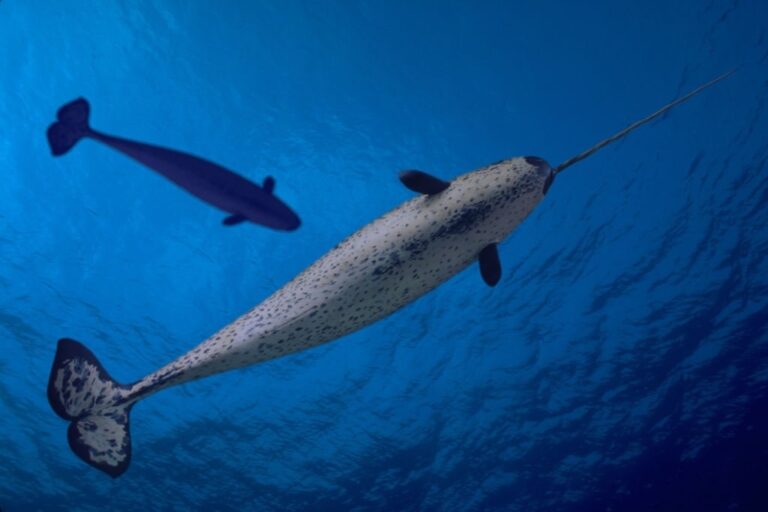The Odd-Looking Narwhal
Affectionately known as the unicorn of the sea.
By: Kirsten Brooker | August 21, 2025 | 767 Words

(Photo by: David Fleetham/VW PICS/Universal Images Group via Getty Images)
The Earth’s oceans are home to many fish and other aquatic species. Some have rather odd-looking features, especially the narwhal. It is known as the unicorn of the sea because of the strange and noticeable tusk, or tusks (some have two), that protrude from the skull of the male narwhals. The whale-like creature lives in the frigid waters of the Arctic Ocean and the Northern Atlantic and spends its days searching for food.
Ancestry and Evolution
The narwhal is most closely related to the beluga whale, which is the only other member of the Monodontidae family. It is not uncommon for narwhals to successfully mate with belugas. The narwhal is related to, though distantly, other whales, dolphins, and cetaceans.
The name given to these sea creatures correlates with their pale complexion and comes from an Old Norse word “nar,” meaning corpse. The animal’s scientific name, monodon monoceros, is Greek, meaning one tooth, one horn.
Vikings would make cups out of the tusks of a narwhal, believing that it had some sort of magical power to prevent poisoning. Other cultural groups, such as the Inuit, Scots, and Britons, believed in the powers of a narwhal tusk, much like the Vikings. They felt that it was a cure for diseases and bad luck in general.
Behavior and Appearance
 Narwhals tend to hang out in pods of around 15 to 20. However, in the warmer months, they can be spotted in groups of more than a thousand. Outside their groups, they are rather solitary. Scientists know very little about narwhals, which don’t survive more than a few months in captivity, making it difficult for researchers to learn in depth about the animal and its behavior.
Narwhals tend to hang out in pods of around 15 to 20. However, in the warmer months, they can be spotted in groups of more than a thousand. Outside their groups, they are rather solitary. Scientists know very little about narwhals, which don’t survive more than a few months in captivity, making it difficult for researchers to learn in depth about the animal and its behavior.
As far as appearance goes, much more has been learned by comparison to behavior and migration. Narwhals range between 13 and 20 feet in length, with the male tusk extending that by about 10 feet. They weigh around 1.5 tons, which calculates to around 3,000 pounds! Both the length and weight of male narwhals exceed those of the females.
Beyond their tusk, notable are the narwhal’s upturned flippers and absence of a dorsal fin. In its place is a dorsal ridge that is unique to each mammal. This helps scientists to easily identify specific narwhals in the wild.
Thick blubber helps the mammal to stay warm in the frigid cold waters of the Arctic, and specialized hemoglobin in their blood allows them to spend a lengthy amount of time beneath the water’s surface. They occasionally come to the surface to replenish their oxygen levels.
Diet of the Narwhal
Narwhals prefer to feed on squid, shrimp, cod, halibut, and other fish species. They will dive down as far as 3,000 feet to search for their preferred prey. In the warmer months, narwhals rely heavily on their fat stores. They eat much less during these months and therefore spend more time near the surface of the water.
Predators
 Narwhals live in such icy conditions that they do not face too many predatory dangers. Their greatest threats are orcas, sharks, and humans. Occasionally, large animals such as polar bears and walruses will attack narwhals, but primarily only when they feel threatened, scared, or trapped. Adult narwhals can be defensively aggressive, so the young, sick, and elderly are more commonly sought out by potential predators.
Narwhals live in such icy conditions that they do not face too many predatory dangers. Their greatest threats are orcas, sharks, and humans. Occasionally, large animals such as polar bears and walruses will attack narwhals, but primarily only when they feel threatened, scared, or trapped. Adult narwhals can be defensively aggressive, so the young, sick, and elderly are more commonly sought out by potential predators.
The Inuit people are perhaps the greatest threat to narwhals, as they have hunted them for thousands of years. The Inuit use nearly every part of the mammal to their advantage, such as the blubber for light and cooking, their meat for a nice meal and a good source of vitamin C, and the tusks to make weapons and other tools.
Not Quite Narwhal
Not Quite Narwhal is a TV series presented by DreamWorks in 2003. The series is based on an award-winning picture book written by Jessie Sima. With a target audience of toddlers to preschool-aged children, the cartoon displays adorable characters with the main one that feels different from the rest of his narwhal family. He later discovers he is actually a unicorn. The well-loved cartoon for young children teaches about accepting the differences between people and families.

- Narwhals are most closely related to beluga whales, and it is not uncommon for them to successfully mate.
- Narwhals tend to hang out in pods of around 15 to 20. However, in the warmer months, they can be spotted in groups of more than a thousand.
- Thick blubber helps narwhals stay warm in frigid Arctic waters, and specialized hemoglobin in their blood allows them to spend a lengthy amount of time beneath the water’s surface.
















